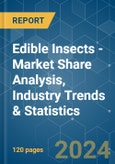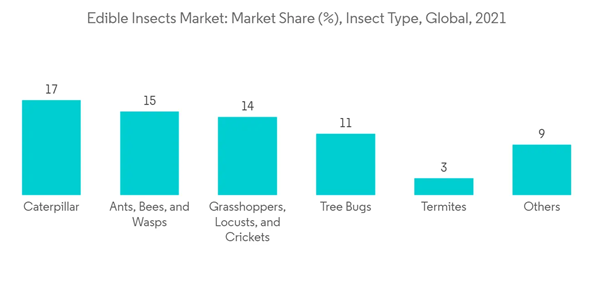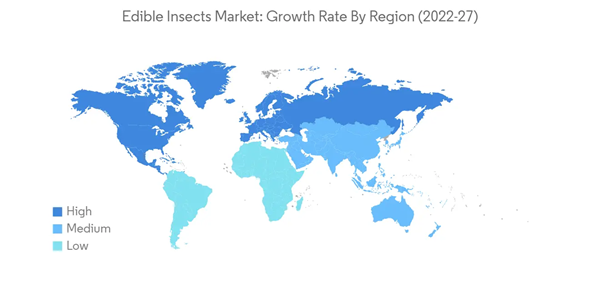The Edible Insects Market size is estimated at USD 3.80 billion in 2024, and is expected to reach USD 9.04 billion by 2029, growing at a CAGR of 18.89% during the forecast period (2024-2029).
Among the edible insects, beetles constitute the largest volume share. Insects are sustainable sources of amino acids and proteins. They are also rich in Omega-3, minerals, dietary fiber, and fatty acids. The insects were also found to be good sources of micronutrients like iron, zinc, magnesium, manganese, phosphorus, and selenium. The vitamin content in edible insects includes riboflavin, pantothenic acid, biotin, and, in some cases, folic acid. Due to multiple nutritional elements, insects are rapidly added to the food and beverage industry. The shifting trend towards sustainable practices will likely push the market in the coming years.
A study conducted by FAO Edible Insects from a Food Safety Perspective Report 2021 stated that 92 percent of known edible insect species are wild-harvested, 6 percent are semi-domesticated, and 2 percent are farmed. Among the known wild-harvested edible insect species, 88 percent are terrestrial, and the remaining are collected from aquatic ecosystems. Recently, some other insect species have been farmed intensively; for instance, the industrialized production of house crickets (Acheta domesticus) in the United States of America mainly for pet food and fishing bait (Morales-Ramos et al., 2020).
In the context of the growing interest in edible insects on the European market, certain national policy attention and prompt regulatory response were generated. In the European Union (EU) whole insects and their ingredients are included under Regulation (EU) No 2015/2283 on novel foods (or the 'new' novel food regulation). The Regulation came into force on 1st January 2018 and requires pre-market authorizations before commercializing these products across the EU market.
Gaining production of insect-based products (whole insects, insect ingredients, and products incorporated with edible insects) placed on the European market, massive investments for the channel in marketing, and increase in consumption is driven by several factors, notably the expected authorization of insects as a novel food, the diversity in products on the market, availability of the product (e.g. availability in retail outlets) and the consumers' acceptance are some of the essential factors boosting the edible insects market during the coming years.
This product will be delivered within 2 business days.
Key Highlights
- Entotarians (one whose diet includes insects but no other meats) is a novel concept that came into existence as a problem solver to feed the estimated 10 billion people that the world will have in some years. The growing number of entotarians has intensified the demand for edible insects worldwide.
- In addition, due to consumer desire for more sustainable and alternative food and feed products, the use of edible insects has been gradually developing. For instance, according to recent estimates, approximately 2,111 species of insects are consumed in about 140 countries, with entomophagy documented around the world like in Asia, Australia, Africa, and the Americas are already consumed regularly by people and domestic animals across the globe owing to their high protein, healthy fat, mineral, and vitamin content.
- The consumption of insects in the tropical and sub-tropical Asian regions from various insect groups in these regions. Insect-eating habits are not only associated with nutritional aspects but are also closely related to socio-cultural practices and religious beliefs. Edible insects are also used to complement diets with rich protein sources and ecologically sustainable sources of the region's food.
- According to the FAO Edible Insects from a Food Safety Perspective, Report 2021, there are some regulatory frameworks for edible insects in distinct countries to govern the production and commercialization of insects in food and feed supply chains. For instance, in the United States, in the year 2020, the food uses of edible insects, insect parts, or derivatives fall within the oversight of the United States of America Food and Drug Administration (FDA). As such, edible insects and insect-based food products must comply with the Federal Food, Drug, and Cosmetic Act (FD&C Act) and its implementing regulations. For example, if insects and insect derivatives are to be used as food or color additives, these uses must be approved by the FDA.
- Many government associations are developing numerous projects and initiatives to focus on investments, research, and industry partners to escalate the edible insects business globally. For instance, in October 2022, the Australian Centre for International Agricultural Research (ACIAR) collaborated with AgriFutures Australia and the International Centre for Insect Physiology and Ecology (ICIPE) to create a new research hub launched in Australia, which derives the emerging insect technology with industries using insects as human food, animal feed, fertilizer and other products such as oil.
Edible Insects Market Trends
Easy Availability and High Protein Content in The Edible Insects
The accessibility and affordability of edible insects are high in the market. They can be easily cultivated, procured, and incorporated into the daily diet as additives in various forms or as a whole, thereby enhancing the overall nutritional quality of the food. In addition, these insects exhibit minimal processing operations during post-harvest, thus providing a highly economical alternative to animal-based meat products.Among the edible insects, beetles constitute the largest volume share. Insects are sustainable sources of amino acids and proteins. They are also rich in Omega-3, minerals, dietary fiber, and fatty acids. The insects were also found to be good sources of micronutrients like iron, zinc, magnesium, manganese, phosphorus, and selenium. The vitamin content in edible insects includes riboflavin, pantothenic acid, biotin, and, in some cases, folic acid. Due to multiple nutritional elements, insects are rapidly added to the food and beverage industry. The shifting trend towards sustainable practices will likely push the market in the coming years.
A study conducted by FAO Edible Insects from a Food Safety Perspective Report 2021 stated that 92 percent of known edible insect species are wild-harvested, 6 percent are semi-domesticated, and 2 percent are farmed. Among the known wild-harvested edible insect species, 88 percent are terrestrial, and the remaining are collected from aquatic ecosystems. Recently, some other insect species have been farmed intensively; for instance, the industrialized production of house crickets (Acheta domesticus) in the United States of America mainly for pet food and fishing bait (Morales-Ramos et al., 2020).
Europe Dominates the Market
Europe continues to dominate the global edible insects market. The growing interest in the edible insect market is due to the growing demand for protein-rich food and the diversification of protein sources consumption in European countries. The edible insect and insect based-food sector has recently increased in the quantities produced and traded owing to awareness-raising actions and the development of European regulations. According to the FAO, insects are part of the diet of more than two billion people around the world. Currently, edible insects represent a niche market in western societies. However, insect farming is a growing industry in Europe as our dietary habits are rapidly changing and the willingness of consumers to try insect-based food is increasing.In the context of the growing interest in edible insects on the European market, certain national policy attention and prompt regulatory response were generated. In the European Union (EU) whole insects and their ingredients are included under Regulation (EU) No 2015/2283 on novel foods (or the 'new' novel food regulation). The Regulation came into force on 1st January 2018 and requires pre-market authorizations before commercializing these products across the EU market.
Gaining production of insect-based products (whole insects, insect ingredients, and products incorporated with edible insects) placed on the European market, massive investments for the channel in marketing, and increase in consumption is driven by several factors, notably the expected authorization of insects as a novel food, the diversity in products on the market, availability of the product (e.g. availability in retail outlets) and the consumers' acceptance are some of the essential factors boosting the edible insects market during the coming years.
Edible Insects Industry Overview
The edible insects market is highly fragmented, as most companies are new in the market studied and hold only a tiny fraction of the market share, as per the companies profiled in the study. Exo Inc., Thailand Unique, Entomo Farms Ltd., Kreca Ento - Feed BV, and Enviro Flight LLC are some prominent companies that account for a significant share of the edible insect market. Product innovations and new product launches are among the most popular market strategies among the players in the market studied. The significant players primarily focus on investing in R&D and enhancing their production capacities to cope with the ever-increasing demand and stay relevant in the market.Additional Benefits:
- The market estimate (ME) sheet in Excel format
- 3 months of analyst support
This product will be delivered within 2 business days.
Table of Contents
1 INTRODUCTION
4 MARKET DYNAMICS
5 MARKET SEGMENTATION
6 COMPETITIVE LANDSCAPE
Companies Mentioned (Partial List)
A selection of companies mentioned in this report includes, but is not limited to:
- Thailand Unique
- Nordic Insect Economy Ltd.
- Kreca Ento - Feed BV
- Entomo Farms Ltd.
- Exo Inc.
- Proti - Farm
- Enviro Flight LLC
- Bugsy Bros
- Deli Bugs Ltd.
- Eat Grub Ltd
Methodology

LOADING...










